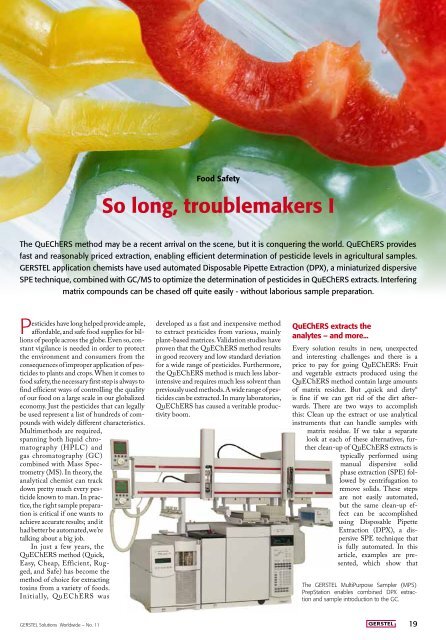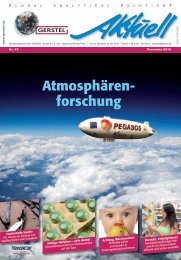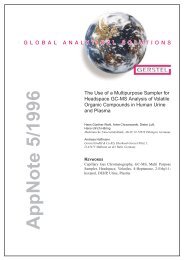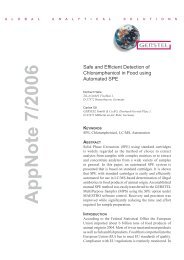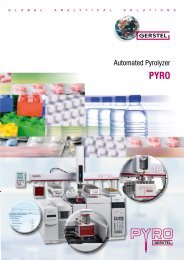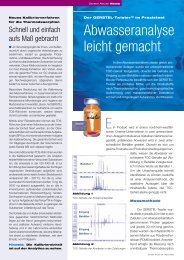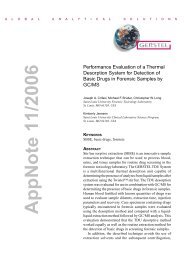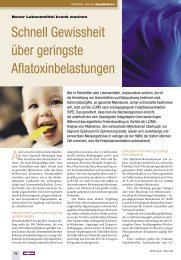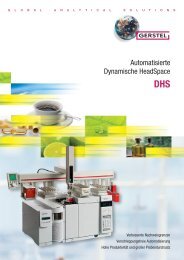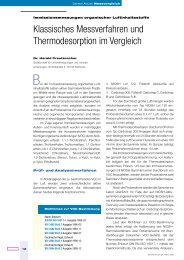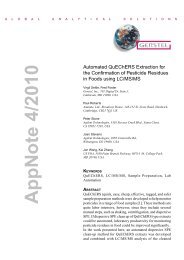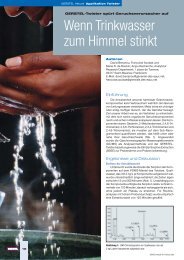download article (pdf; 0,18 MB) - Gerstel
download article (pdf; 0,18 MB) - Gerstel
download article (pdf; 0,18 MB) - Gerstel
Create successful ePaper yourself
Turn your PDF publications into a flip-book with our unique Google optimized e-Paper software.
Food Safety<br />
So long, troublemakers I<br />
The QuEChERS method may be a recent arrival on the scene, but it is conquering the world. QuEChERS provides<br />
fast and reasonably priced extraction, enabling efficient determination of pesticide levels in agricultural samples.<br />
GERSTEL application chemists have used automated Disposable Pipette Extraction (DPX), a miniaturized dispersive<br />
SPE technique, combined with GC/MS to optimize the determination of pesticides in QuEChERS extracts. Interfering<br />
matrix compounds can be chased off quite easily - without laborious sample preparation.<br />
Pesticides have long helped provide ample,<br />
affordable, and safe food supplies for billions<br />
of people across the globe. Even so, constant<br />
vigilance is needed in order to protect<br />
the environment and consumers from the<br />
consequences of improper application of pesticides<br />
to plants and crops. When it comes to<br />
food safety, the necessary first step is always to<br />
find efficient ways of controlling the quality<br />
of our food on a large scale in our globalized<br />
economy. Just the pesticides that can legally<br />
be used represent a list of hundreds of compounds<br />
with widely different characteristics.<br />
Multimethods are required,<br />
spanning both liquid chromatography<br />
(HPLC) and<br />
gas chromatography (GC)<br />
combined with Mass Spectrometry<br />
(MS). In theory, the<br />
analytical chemist can track<br />
down pretty much every pesticide<br />
known to man. In practice,<br />
the right sample preparation<br />
is critical if one wants to<br />
achieve accurate results; and it<br />
had better be automated, we’re<br />
talking about a big job.<br />
In just a few years, the<br />
QuEChERS method (Quick,<br />
Easy, Cheap, Efficient, Rugged,<br />
and Safe) has become the<br />
method of choice for extracting<br />
toxins from a variety of foods.<br />
Initially, QuEChERS was<br />
developed as a fast and inexpensive method<br />
to extract pesticides from various, mainly<br />
plant-based matrices. Validation studies have<br />
proven that the QuEChERS method results<br />
in good recovery and low standard deviation<br />
for a wide range of pesticides. Furthermore,<br />
the QuEChERS method is much less laborintensive<br />
and requires much less solvent than<br />
previously used methods. A wide range of pesticides<br />
can be extracted. In many laboratories,<br />
QuEChERS has caused a veritable productivity<br />
boom.<br />
QuEChERS extracts the<br />
analytes – and more...<br />
Every solution results in new, unexpected<br />
and interesting challenges and there is a<br />
price to pay for going QuEChERS: Fruit<br />
and vegetable extracts produced using the<br />
QuEChERS method contain large amounts<br />
of matrix residue. But „quick and dirty“<br />
is fine if we can get rid of the dirt afterwards.<br />
There are two ways to accomplish<br />
this: Clean up the extract or use analytical<br />
instruments that can handle samples with<br />
matrix residue. If we take a separate<br />
look at each of these alternatives, further<br />
clean-up of QuEChERS extracts is<br />
typically performed using<br />
manual dispersive solid<br />
phase extraction (SPE) followed<br />
by centrifugation to<br />
remove solids. These steps<br />
are not easily automated,<br />
but the same clean-up effect<br />
can be accomplished<br />
using Disposable Pipette<br />
Extraction (DPX), a dispersive<br />
SPE technique that<br />
is fully automated. In this<br />
<strong>article</strong>, examples are presented,<br />
which show that<br />
The GERSTEL MultiPurpose Sampler (MPS)<br />
PrepStation enables combined DPX extraction<br />
and sample introduction to the GC.<br />
GERSTEL Solutions Worldwide – No. 11 19
Spinach extract<br />
Orange extract<br />
without<br />
clean-up<br />
clean-up<br />
with<br />
DPX-Qg<br />
without<br />
clean-up<br />
clean-up<br />
with<br />
DPX-Q<br />
clean-up<br />
with<br />
DPX-Qg<br />
Spinach and orange extracts<br />
before and after DPX clean-up.<br />
Schematic diagram of the DPX clean-up.<br />
DPX is an attractive and efficient alternative<br />
for clean-up of spinach and orange extracts.<br />
Should the analyst not want to perform further<br />
clean-up of such extracts prior to GC/<br />
MS analysis, the only remedy is to replace<br />
the GC inlet liner at regular intervals. Liner<br />
exchange is normally a time-consuming<br />
Full scan chromatograms of the spinach extract before (A) and after<br />
(B) DPX clean-up.<br />
SIM chromatogram after DPX clean-up of spinach extract spiked to a<br />
concentration of 200 ppb with a standard pesticide mixture.<br />
task, but GERSTEL‘s Automated Liner<br />
EXchange (ALEX) performs Liner EXchange<br />
automatically, enabling the analysis<br />
of samples with undissolved sample matrix.<br />
Matrix build-up has negative consequences<br />
especially for the GC/MS system: If raw<br />
QuEChERS extracts are injected directly<br />
into the GC, residue will accumulate in the<br />
inlet. This build-up will<br />
lead to compound loss<br />
by adsorption on active<br />
surfaces and increased<br />
variability, negatively<br />
impacting the results.<br />
In combination<br />
with the MultiPurpose<br />
Sampler (MPS),<br />
ALEX performs automated<br />
liner exchange at<br />
user-defined intervals.<br />
Disposable Pipette<br />
Extraction (DPX<br />
DPX is an SPE technique<br />
that relies not<br />
on packed adsorbents<br />
in standard cartridges,<br />
but on adsorbent powder<br />
placed inside disposable<br />
pipette tips.<br />
In the case of spinach<br />
and orange extracts,<br />
graphitized Carbon<br />
Black was used among<br />
other adsorbents (DPX<br />
Qg-tips, as specified<br />
in DIN EN 15662).<br />
Plant colorants, such<br />
as chlorophyll, and free<br />
acids were successfully<br />
removed. The transport<br />
adapter at the top and a<br />
frit at the bottom help<br />
contain adsorbent and<br />
sample inside the pipette<br />
tip while enabling<br />
highly efficient airbubble<br />
induced mixing.<br />
The transport adapter also serves the dual<br />
purpose of allowing the MPS to get a grip<br />
on the cartridge in order to transport it and<br />
to introduce the syringe needle into the cartridge<br />
for liquid transfer. The DPX process is<br />
clever yet simple: The MPS picks up a DPX<br />
tip from the tray. Depending on the method,<br />
the adsorbent can be washed with a suitable<br />
solvent, which is taken from a solvent reservoir.<br />
The solvent can either be aspirated into<br />
the tip from below or added to the top using<br />
the autosampler syringe. A 500 µL sample of<br />
the extract in question was aspirated into the<br />
tip. Extracts had been spiked with organochlorine-<br />
and organophosphorous pesticide<br />
standard mixtures at different concentration<br />
levels. Samples were aspirated into the<br />
DPX tip from below, which means they were<br />
never in contact with the syringe needle or<br />
piston. „There is no sample-to-sample cross<br />
contamination or carry-over“ said Carlos<br />
Gil, Manager, Analytical Services at GER-<br />
STEL Headquarters, while adding: „Since<br />
DPX is a dispersive SPE technique, the extraction<br />
efficiency is not influenced by the<br />
flow path or the flow rate through the adsorbent,<br />
making the technique highly rugged<br />
and reliable“. Once the sample has entered<br />
the DPX tip, the syringe pulls air through<br />
the tip and the sample from below. The liquid<br />
suspension undergoes highly efficient<br />
turbulent mixing leading to optimal contact<br />
between the phases and highly efficient and<br />
fast extraction. „The efficiency of the cleanup<br />
is clearly demonstrated by the fact that<br />
the final spinach extract is almost completely<br />
colorless“, says Carlos Gil. The extraction<br />
takes place in less than two minutes. Then<br />
the cleaned QuEChERS extract is then<br />
transferred directly to a clean autosampler<br />
vial for analysis or to undergo further liquid<br />
sample preparation steps prior to the analysis<br />
as needed. The used pipette tip is discarded.<br />
As soon as the prepared sample has been introduced<br />
to the GC system, a clean pipette<br />
tip is picked up and the next sample prepared.<br />
„Analysis and sample preparation are<br />
performed in parallel, ensuring best possible<br />
utilization and return on investment for the<br />
entire instrument set-up“, says Carlos Gil.<br />
20 GERSTEL Solutions Worldwide – No. 11
The power of DPX - conclusion<br />
Apart from the visible removal of spinach and orange matrix, the<br />
analysis results bear testament to the efficiency of the DPX process.<br />
Carlos Gil: „The results were convincing, we had excellent<br />
recovery of the organochlorine- and organophosphorous pesticides<br />
that were determined in the study“. The relative standard<br />
deviation (n=3) was under 10 % both for the extract spiked at 20<br />
ppb and for the extract spiked at 200 ppb. Average recoveries were<br />
119 % for the orange sample and 91 % for the spinach. The study<br />
proved that automated DPX is useful for second stage clean-up<br />
of QuEChERS extracts prior to GC/MS analysis. The DPX tips<br />
efficiently removed interfering matrix material, improving overall<br />
system reliability and productivity, and reducing the need for<br />
maintenance since there was less residue build-up in the GC/MS<br />
system.<br />
Method parameters<br />
The analysis was performed on a GC 7890 / MSD 5975C<br />
GC/MS system (Agilent Technologies) configured with a<br />
GERSTEL Cooled Injection System (CIS) PTV-type inlet and a<br />
GERSTEL MultiPurpose Sampler (MPS) sample preparation<br />
robot fitted with a 10 µL syringe for liquid injection.<br />
Analysis parameters<br />
CIS 4: splitless<br />
25 °C; 12 °C/s; 280 °C<br />
(3 min)<br />
Column: 30 m DB5-MS (Agilent)<br />
di = 0.25 mm; df = 0.25 µm<br />
Carrier gas: He, constant flow<br />
1.0 mL/min<br />
GC oven: 60 °C (1 min); 10 °C/min;<br />
300 °C (3 min)<br />
Standards<br />
A standard mixture of organochlorine- and organophosphorous<br />
pesticides at a concentration of 1000 µg/L was prepared<br />
in Acetonitrile.<br />
Sample preparation<br />
For quantification purposes, fruit and vegetable extracts were<br />
spiked with diluted pesticide standards. (Concentrations: 20<br />
µg/L and 200 µg/L in 500 µL extract).<br />
DPX extraction<br />
1 mL QuEChERS tips from DPX-Labs, LLC. 500 µL of the<br />
fruit- or vegetable extract was automatically transferred to a<br />
vial by the MPS fitted with a 2.5 mL syringe. A 1 µL aliquot<br />
of the extract was introduced to the GC.<br />
More information<br />
http://www.gerstel.de/<strong>pdf</strong>/p-gc-an-2009-01.<strong>pdf</strong><br />
The sequence table for automated DPX sample preparation is easily and quickly<br />
set up by mouse-click in the MAESTRO.<br />
Orange<br />
Spinach<br />
Analyte % Recovery % RSD % Recovery % RSD<br />
20 ppb 200 ppb 20 ppb 200 ppb 20 ppb 200 ppb 20 ppb 200 ppb<br />
Dichlorvos 139 80 14 15 92 51 8.3 15<br />
Mevinphos 89 68 15 10 60 34 8.3 15<br />
Phorate 68 122 16 3.7 16 93 32 5.2<br />
α-BHC 100 113 5.9 4.4 47 76 16 6.2<br />
δ-BHC 126 89 6.3 8.2 105 51 17 24<br />
Diazinon 151 116 5.1 4.4 117 96 2.5 3.9<br />
Methyl Parathion 263 104 7.9 12 165 54 20 14<br />
Ronnel 97 75 5.5 5.8 95 63 11 9.8<br />
Aldrin 173 138 5.2 3.4 148 124 1.9 3.3<br />
Trichloronate 119 74 26 3.6 152 87 8.3 6.8<br />
Heptachlor Epoxide 142 135 4.3 3.0 120 102 4.2 3.4<br />
t-Chlordane 147 140 4.9 2.7 135 116 3.7 3.5<br />
Prothiofos 131 98 1.9 4.0 162 104 4.7 6.3<br />
Dieldrin 168 137 5.2 2.4 128 123 9.0 3.2<br />
Endrin 167 149 6.5 4.0 142 1<strong>18</strong> 5.4 3.9<br />
β-Endosulfan 156 134 4.7 2.9 138 102 12 7.4<br />
Fensulfothion 121 142 6.9 5.1 63 88 4.6 11<br />
Sulprofos 196 136 3.6 4.3 200 122 4.3 6.4<br />
DDT 213 179 4.5 11 208 117 6.9 7.3<br />
Endrin Keton 174 144 2.6 3.8 138 97 2.1 7.7<br />
Average 147 119 7.6 5.7 122 91 9.1 8.2<br />
Percent recovery and relative standard deviation for the pesticides.<br />
Analyte Orange Spinach<br />
No DPX DPX No DPX DPX<br />
Dichlorvos 128 80 120 51<br />
Mevinphos 179 68 145 34<br />
Phorate <strong>18</strong>0 122 170 93<br />
α-BHC 158 113 150 76<br />
δ-BHC 213 89 170 51<br />
Diazinon 162 116 160 96<br />
Methyl Parathion 483 104 300 54<br />
Ronnel 196 75 195 63<br />
Aldrin 204 138 210 124<br />
Trichloronate 242 74 245 87<br />
Heptachlor Epoxide 198 135 155 102<br />
t-Chlordane 167 140 175 116<br />
Prothiofos 257 98 265 104<br />
Dieldrin 198 137 260 123<br />
Endrin 197 149 195 1<strong>18</strong><br />
β-Endosulfan 192 134 <strong>18</strong>0 102<br />
Fensulfothion 197 142 165 88<br />
Sulprofos 246 136 250 122<br />
DDT 224 179 195 117<br />
Endrin Ketone 168 144 155 97<br />
Average 209 119 193 91<br />
Recovery of the pesticides with and without DPX clean-up<br />
(spiked to a concentration level of 200 ppb).<br />
GERSTEL Solutions Worldwide – No. 11 21


